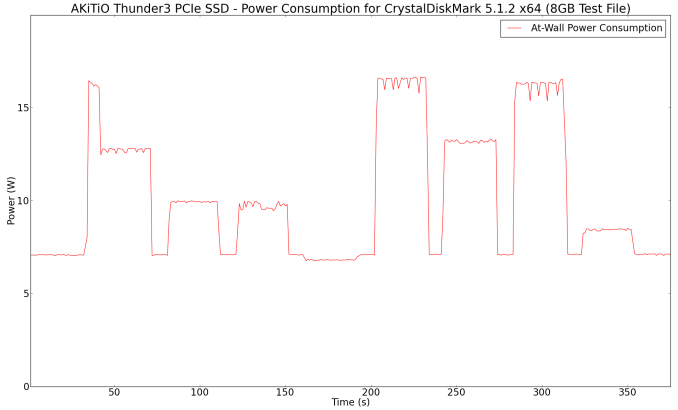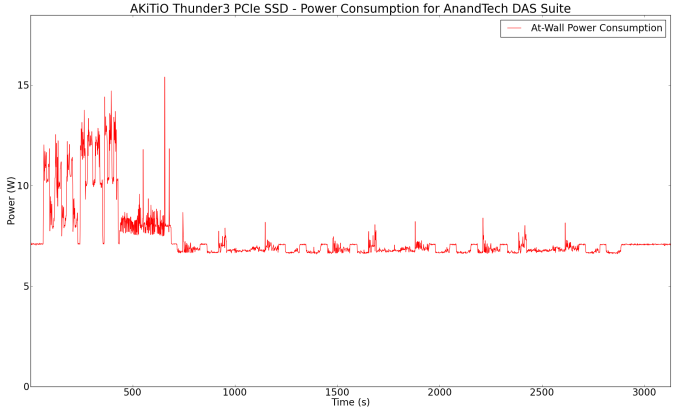AKiTiO Thunder3 PCIe SSD Thunderbolt DAS Review
by Ganesh T S on June 2, 2016 8:00 AM EST- Posted in
- Storage
- Thunderbolt
- PCIe SSD
- DAS
- Thunderbolt 3
- Akitio
We have already talked about the Thunderbolt software and how it provides more security compared to connecting traditional USB peripherals. Detailed coverage of the Intel SSD Toolbox is also beyond the scope of this review. However, there are a couple of aspects - performance consistency and power consumption - that bear relevance in the day-to-day usage of the Thunder3 PCIe SSD.
Performance Consistency
Our performance consistency test takes the robocopy benchmark described in the previous section and instruments it to record the drive temperature as well as instantaneous transfer rates during the process.
The active thermal solution helps a lot, with the SSD barely going above 33C in the course of transferring more than 250GB of data continuously. There is absolutely no thermal throttling at play in the Thunder3 PCIe SSD, and we don't expect any workload to be really able to stress the fan-based cooling mechanism much.
Power Consumption
The power consumption of the Thunder3 PCIe SSD was recorded at the wall while processing the CrystalDiskMark benchmark, as well as over the course of processing our DAS test suite (including PCMark 8 storage bench).
The above graphs show that the PCIe SSD itself can consume upwards of 16W for certain workloads. The unit idles at around 7W. Utilizing the DisplayPort output and/or adding another device in a daisy-chain configuration is also bound to drive up these numbers (particularly if the added device is bus-powered).
Final Words
The strength of the Intel SSD 750 lies in performance consistency with random I/O intensive workloads. This is not something evident in the typical DAS workload. That said, the SSD 750 has the highest possible capacity of any consumer drive model that uses a PCIe 3.0 x4 NVMe interface. Considering the target market, it makes sense that AKiTiO uses the highest capacity model in the only version of the Thunder3 PCIe SSD. On the other hand, a bus-powered enclosure using a M.2 SSD with a better guaranteed endurance rating (in terms of drive writes per day (DWPD)) would be nice, though such a product would probably target a different use-case.
Coming to the business end of the review, it can definitely be said that the Thunder3 PCIe SSD is a unique product - It is the only product we are aware of that can put the Intel SSD 750 to use in a direct-attach scenario. The key here is that the storage is not tied to a single computer, and a portability option is available. Such fast and massive storage is a boon for multimedia editors working as a team, or, across multiple locations.
The pricing aspect is a bit shocking at first - $1300 for 1.2TB is more than $1/GB (the last Thunderbolt SSD that we evaluated - the LaCie Rugged Thunderbolt - was priced at $1/GB, but limited to SATA speeds). However, one must note that the Intel SSD 750 1.2TB add-in card itself still retails between $1018 and $1150. The Thunderbolt 3 enclosure with daisy-chaining capabilities and a dedicated DisplayPort output adds comparatively little to the final cost of the Thunder3 PCIe SSD. Considered standalone, the Thunder3 PCIe SSD is an technically exciting product that will also draw the attention of professional users. We would like to see AKiTiO add a bus-powered PCIe SSD to round out their Thunderbolt 3 Series.














28 Comments
View All Comments
samer1970 - Friday, June 3, 2016 - link
When you buy SSD look for TBW ratingintel 750 is bad it has ONLY 219TB writes
intel P3700 however has 36500TB writes !!!
for just double the price (3700) you get 166 TIMES the writes of 750 .. so it is NOT EXPENSIVE AT ALL TO GET P3700
intel 750 is a bad choice ... for double the price you get 166 times better
Impulses - Friday, June 3, 2016 - link
This would actually be pretty sweet for someone heavy into content creation but who prefers a laptop over a desktop... You can obviously make the argument that nobody should have that preference (certainly not at a professional level), but still...Having an external 750 that can house say, your Lightroom library, Premier scratch space, and a bunch of photos or 4K video you're currently working on is certainly gonna see some benefits over many internal laptop SSD solutions... If nothing else it gives you more space (w/o a perf. sacrifice) than what most laptops would come with, even if it's an SM951.
A niche product for sure, but it's actually priced a lot more aggressively than many of LaCie's DAS.
invinciblegod - Friday, June 3, 2016 - link
Is it possible to use an adapter to attach a thunderbolt 1-2 device downwards on the chain?ganeshts - Monday, June 6, 2016 - link
Should be possible.. I am getting hold of an adapter shortly, and will be able to tell one way or the other pretty soon.poohbear - Saturday, June 4, 2016 - link
What are these reviews of obscure products? Where's the GTX 1070 review??lmcd - Saturday, June 4, 2016 - link
Given that different editors do different pieces this is one of the most ignorant Anandtech comments of all time.jabber - Sunday, June 5, 2016 - link
How many reviews do you need to 'convince' you to buy a product you are already going to buy? Some of us only need to read a couple and then like something else to read about.jbrizz - Monday, June 6, 2016 - link
One would think this is targeted towards people doing video editing, but 128TBW (70GB per day) seems a bit low for that kind of use case.